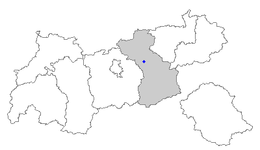Schwaz
| Schwaz | ||
|---|---|---|
|
||
| Location within Austria | ||
| Coordinates: 47°21′00″N 11°42′00″E / 47.35000°N 11.70000°ECoordinates: 47°21′00″N 11°42′00″E / 47.35000°N 11.70000°E | ||
| Country | Austria | |
| State | Tyrol | |
| District | Schwaz | |
| Government | ||
| • Mayor | Hans Lintner (ÖVP) | |
| Area | ||
| • Total | 20.17 km2 (7.79 sq mi) | |
| Elevation | 545 m (1,788 ft) | |
| Population (1 January 2016) | ||
| • Total | 13,444 | |
| • Density | 670/km2 (1,700/sq mi) | |
| Time zone | CET (UTC+1) | |
| • Summer (DST) | CEST (UTC+2) | |
| Postal code | 6130 | |
| Area code | 05242 | |
| Vehicle registration | SZ | |
| Website | www.schwaz.at | |
Schwaz (German: [ˈʃvaːts]) is a city in the Austrian state of Tyrol. It is the administrative center of the Schwaz district. Schwaz is located in the lower Inn valley.
Schwaz lies in the middle of the Lower Inn Valley at the foot of the Kellerjoch and Eiblschrofen mountains. It is located approximately 30 km (19 mi) east of Innsbruck.
The city covers an area of 20.17 km2 (7.79 sq mi).
Neighbouring communities include: Buch bei Jenbach, Fügenberg, Gallzein, Pill, Stans, and Vomp.
The Counts of Tyrol guarded Schwaz from nearby Burg Freundsberg. At the town's height during the 15th and 16th centuries, it was an important silver mining center, providing mineral wealth for both the Fugger banking family and, through them, for the Austrian emperors. During this period, its population of about 20,000 inhabitants made it the second largest city in the Austrian Empire, after Vienna.
Schwaz received its city rights in 1898 by Emperor Franz Joseph I of Austria.
...
Wikipedia



